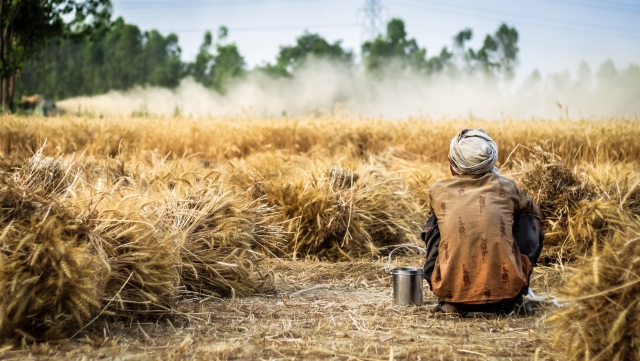India’s 2023-24 wheat crop seen slightly lower on year, below govt estimates

India’s wheat harvest in marketing year 2023-24 (April-March) is likely slightly lower year on year, at 107 million-108 million mt, as market participants saw a slight drop in yields despite steady acreage under the crop, an S&P Global Commodity Insights survey of 13 analysts and traders found.
The trade estimate is lower than the Ministry of Agriculture’s MY 2022-23 estimate, at 110.55 million mt. For MY 2023-24, the ministry targeted wheat output at 114 million mt.
India is the world’s second-largest wheat producer and consumer after China.
“Although the acreage is steady compared with last year, the yield is expected to be lower as showers [were] deficient in 2023,” an official with a multinational firm said.
Wheat, the second-largest food grain sown in India after rice, is planted during October-November and harvested over February-March.
However, as an El Nino phenomenon emerged, rain was insufficient during the monsoon season, leading to poor soil moisture and a drier winter. In 2023, monsoon showers during June-September were at 94.4% of the long-period average, according to the India Meteorological Department.
Winter rains in India over Jan. 1-Feb. 18 were 46% lower than the average at 16.8 mm, IMD data showed. Winter showers are crucial for wheat yields as it maintains soil moisture.
So far, winter rainfall has been poor in key wheat-growing states of Uttar Pradesh, Madhya Pradesh, Punjab, Rajasthan and Haryana.
“Poor showers during the winter months in northern states may hit yields severely,” a Delhi-based trader said.
Traders are observing the markets during the harvest over March-April. In the past two years, India’s wheat harvest shrank due to severe heatwaves during March-April.
In MY 2022-23, the government pegged India’s wheat output at 112.2 million mt before reducing the estimates to 110.55 million mt.
“Heatwaves during March-April may weigh on the overall wheat harvest in India,” a trader based in Madhya Pradesh said. “They will also hit the yields and quality of the crop as they did over the last two years.”
Supply tightness to continue
Supply tightness in the domestic wheat markets will likely continue as the government depleted its reserve stocks and may look to replenish aggressively, traders said.
India’s wheat stocks dwindled to a seven-year low as of Dec. 31, 2023, when the Food Corporation of India recorded 16.35 million mt of wheat in government warehouses, compared with 17.17 million mt the previous year.
Wheat prices at spot markets declined 16% on the year to Rupee 26,000/mt ($313.21) in the week to Feb. 16, traders said.
“The government may look at ways to aggressively procure wheat from open markets to keep the food distribution program viable,” a Punjab-based trader said.
The supply tightness may escalate over coming months as the government will likely explore ways to replenish stocks after recently extending the scheme to provide free food grains to over 810 million beneficiaries for five years effective Jan. 1, 2024.
“If the government ends up buying more wheat from farmers, it may lead to supply tightness in the wholesale markets,” another Punjab-based trader said.
Trade policy changes unlikely
Despite the likely output drop, traders are not expecting the government to allow imports at a lower duty or call on allowing exports ahead of the elections.
“Since farmers are a key constituency in large wheat-producing states, the ruling party is not willing to risk angering them and is not engaging in talks about imports,” a trader based in Kanpur, Uttar Pradesh, said. Uttar Pradesh is the largest wheat-producing state and the most populous province in the country.
While traders have been seeking an import duty cut, the government is waiting to see the crop quality and harvest quantity before deciding on imports, an official with the agriculture ministry said. Currently, the government levies a 40% import duty on wheat.
According to officials, allowing imports may weigh on returns to farmers and hit sentiments ahead of the elections. India’s national elections are expected to be held during April-May, with local media reports indicating a comeback of the ruling dispensations.
Meanwhile, a few in the trade circles said if the wheat harvest rebounds, the government may look at allowing exports post-elections.
India banned exports in May 2022, after domestic supplies tightened amid a drop in output and ambitious export target. In MY 2022-23, India planned to export nearly 10 million mt of wheat, but ended up shipping nearly 5 million mt.
If the output is better than expected, the government may be willing to allow exports, but any significant change to the trade policy is unlikely before the elections, a trader based in Mumbai said.
Read also
Write to us
Our manager will contact you soon



